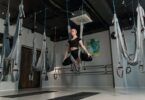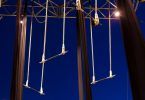When it comes to aerial acrobatics training, whether you’re practicing pole fitness, aerial silks, or other aerial disciplines, the question often arises: Do aerial sports require training? The answer is a resounding yes. Structured training is not only crucial for learning advanced techniques but also for avoiding common pitfalls like injury and burnout. This article explores why gradual progression is essential and how it leads to long-term success in aerial sports.
The Importance of Properly Structured Aerial Acrobatics Training
1. Do Aerial Sports Require Training? Avoiding Injury Risks
It is essential to introduce tricks at a steady pace, beginning with easier ones and gradually progressing to more challenging and complex combinations. This approach allows us to foster trainees’ self-confidence as they build their skills and trust in their abilities, working hand in hand with their coach. Rushing through movements and making errors due to impatience can significantly heighten the risk of injury.
2. Why Rushing Aerial Sports Training Leads to Confusion
Every movement, whether performed on the floor or in the air, has its distinct name and technique. When students rush through their training, they may initially appear to have achieved a certain level of proficiency. However, as time progresses, they often experience confusion and uncertainty about what they have learned. It is crucial to prioritize a thorough understanding of each move to avoid such confusion and ensure meaningful progress in their acrobatic journey.
3. Loss of Initial Enthusiasm
When students embark on their aerial acrobatics journey, they are often filled with joy and enthusiasm. To nurture their passion and keep them engaged, it is important to consistently provide them with new information and introduce them to new moves during lessons. This approach not only sustains their interest but also allows them to anticipate their training sessions. By offering a blend of novelty and opportunity for improvement, students can simultaneously enhance their technique and build strength, ensuring a fulfilling and progressive learning experience.
4. Gradual Progression
Aerial acrobatics is a discipline that demands patience and a systematic approach. Gradual progression is key to building a strong foundation and advancing safely. Starting with foundational moves allows students to develop strength, flexibility, and body awareness before attempting more complex combinations. By gradually introducing new moves and challenges, students can steadily improve their skills and reduce the risk of overwhelm or injured. A structured progression also helps to maintain motivation and a sense of accomplishment as milestones are reached along the way.
5. Mental Preparation and Mindfulness
Aerial acrobatics not only requires physical prowess but also mental preparedness. Developing a focused and present mindset is crucial for optimal performance. Mindfulness techniques can help aerialists cultivate concentration, manage fear, and enhance their overall experience. By being fully present in the moment and cultivating a positive mindset, students can overcome mental barriers, increase their confidence, and elevate their performance to new heights.
6. Importance of Careful Planning and Patience in Aerial Acrobatics Training
Careful planning and structured training sessions are essential in Pole Fitness, Aerial Silks, and any other sport. This approach allows trainees to gradually build the necessary muscle strength and technique required for aerial lessons.
It’s common for individuals to feel eager and impatient when starting a new activity. As trainers, it is our responsibility to establish the appropriate pace for workouts and help trainees understand the wisdom behind the old saying, “Look before you leap.” By instilling patience and emphasizing the importance of a systematic approach, we can ensure trainees progress safely and effectively on their aerial journey.
7. Resources and Additional Training Options
To enhance your aerial acrobatics training, there are various resources and training options available. Beyond regular classes, consider exploring supplementary resources such as books, online tutorials, workshops, or specialized training programs.
Open Dance Academy, for example, offers online pole dance lessons taught by renowned instructors. As an exclusive offer, you can enjoy a 10% discount using the code “verticalwise”
These additional resources can provide valuable insights, and diverse perspectives, and further support your growth as an aerialist. However, it’s important to note that these resources complement but do not replace the guidance and instruction of a qualified instructor.
Do Aerial Sports Require Training? Conclusion
Taking the time to learn and progress gradually in acrobatic training is crucial for avoiding injuries, maintaining clarity in movement assimilation, and preserving the initial enthusiasm that comes with starting such a dynamic discipline. Remember, patience and a well-structured approach are key to acrobatic success.
Explore aerial training safety guidelines at National Institute for Circus Arts (NICA)








